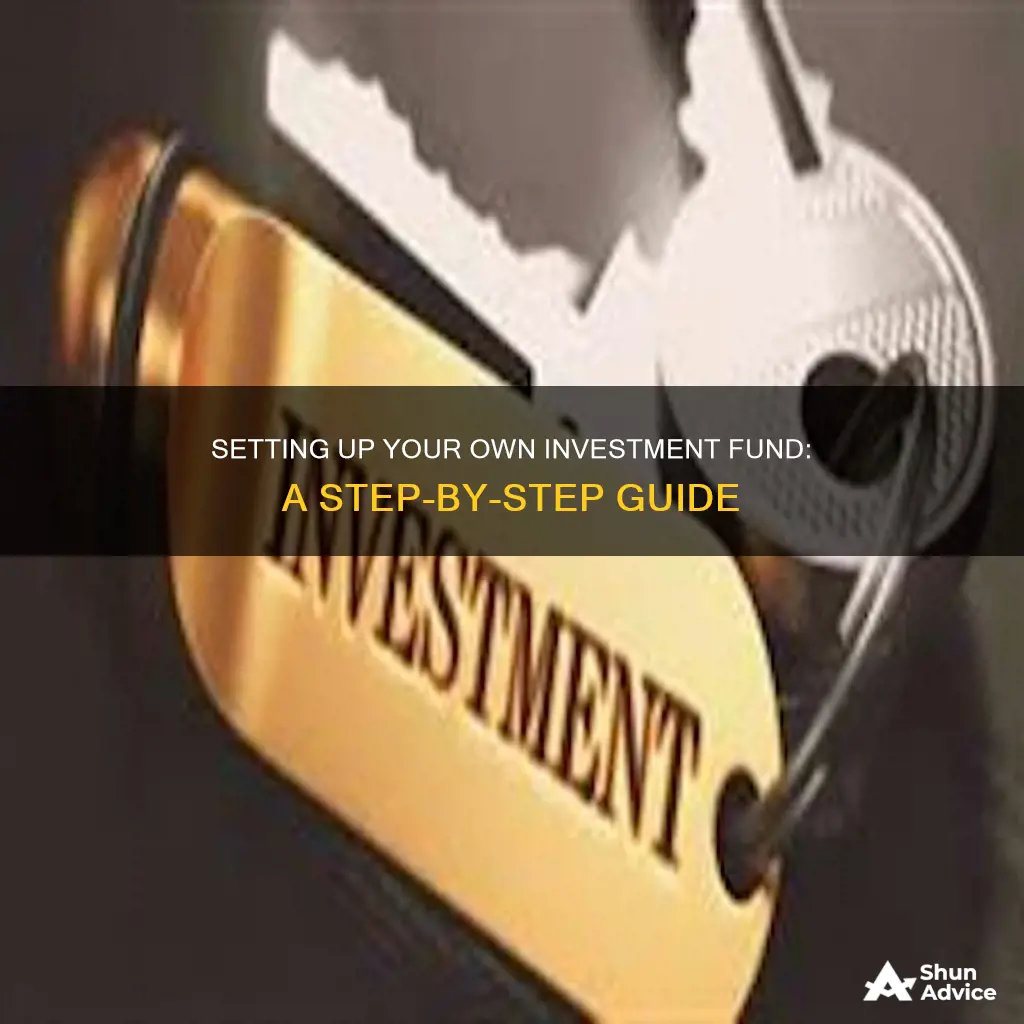
Setting up your own investment fund is no easy feat, but it can be a rewarding and lucrative endeavour. The process involves a number of steps, from defining your investment strategy and business structure to registering with the relevant authorities and assembling a competent team.
There are various types of investment funds, including mutual funds, exchange-traded funds, real estate funds, and hedge funds. Each has its own advantages and considerations. For example, hedge funds offer high flexibility and the ability to employ diverse investment strategies, but they also come with higher risks.
No matter the type of fund, effective marketing and a solid team are crucial for success. Additionally, complying with legal and regulatory requirements is essential to ensure the fund operates within the boundaries of the law.
Let's dive into the steps and strategies for setting up your own investment fund.
| Characteristics | Values |
|---|---|
| First step | Define your business strategy |
| Second step | Write a business plan |
| Third step | Set up your fund management company |
| Fourth step | Prepare the company coffers |
| Fifth step | Reach other people's money |
| Sixth step | Comply with regulations on self-promotion |
| Seventh step | Hire a team |
| Eighth step | Sort out the paperwork and legal/corporate structure |
What You'll Learn

Define your business strategy
Before you start an investment company, you need to outline your business strategy and differentiate your financial plan from your competitors. This requires significant research into a defined market or individual sector. Some funds focus on energy development, while others may focus on early-stage biotech companies.
You should also consider whether you will have a geographic focus. Will your fund focus on one region of a country, or will it emphasise a specific strategy in similar emerging markets?
You should also determine the purpose of each investment. For example, is the aim of the investment to grow capital for mergers and acquisitions activity, or is it to allow existing owners to sell their positions in the firm?
Your business plan should answer the following questions:
- What is your investment strategy? (What is your market, industry or niche?)
- How will you find deals?
- How will you raise money for the fund?
- How much will you charge?
- What will your start-up costs be?
- What will your ongoing expenses be?
You will also need to decide on the type of investment company you want to create. For example, a closed-end investment company issues shares in a one-time public offering, whereas an open-end investment company continuously issues new shares.
You will also need to pick a business structure. Investment companies can be corporations, partnerships, or limited liability companies (LLCs). Each form carries its own risks and benefits, which you should carefully consider.
Corporations are owned by shareholders and run by officers appointed by a board of directors. They shield owners from personal responsibility for business obligations, such as debts or lawsuits.
Partnerships are owned by the partners, who jointly run the business. Partners are personally responsible for the partnership's obligations. In some jurisdictions, you can create a limited partnership, where the general partner is personally liable for the company's obligations, but its limited partners are not.
Limited liability companies are corporation-partnership hybrids, shielding owners (called members) from personal responsibility for business obligations.
Finally, you will need to establish your fund's goals and how you intend to reach them. A business plan will typically contain the following information:
- Company summary: Describe the services you will offer and your business type. Identify the amount of capital you will have at the start and your total start-up expenses.
- Market analysis: Identify the other investment companies you will be competing with and analyse what they do well. Discuss how you will set yourself apart from the competition.
- Marketing plan: Identify your target consumer based on age, location, gender, education, income, etc. Discuss what promotional efforts you will undertake to reach your target market.
- Operations and management: Identify the members of management and discuss their experience and education.
- Financial information: Create projected cash flows, a balance sheet, and business ratios. You should also forecast your sales.
Smart Strategies for Investing $200K in Mutual Funds
You may want to see also

Write a business plan
Writing a business plan is a crucial step in setting up your own investment fund. It will help you secure funding from investors and ensure you've considered all aspects of your business. Here are the key components of a comprehensive business plan:
Executive Summary
Although typically written last, the executive summary serves as an overview of your business. It provides a concise description of your business, including its purpose, target market, competitive advantages, and financial projections. This section is often used as a stand-alone document to give investors a quick snapshot of your business.
Problem and Solution
In this section, describe the problem you are aiming to solve and present your solution. Highlight any data or customer validation that supports your claims. Prove that there is a demand for your solution and that people are willing to pay for it.
Target Market Analysis
Conduct a thorough analysis of your target market. Identify key trends, such as market growth, changing consumer behaviours, and evolving industry dynamics. Demonstrate how your business is positioned to capitalise on these trends and address the needs of your target market effectively.
Competitive Landscape
Discuss your competitors and how your solution differs from or improves upon theirs. Identify their strengths and weaknesses and outline your strategies for differentiating yourself in the market.
Marketing and Sales Plan
Explain your approach to reaching your target market and converting them into customers. Describe the marketing and sales initiatives you plan to undertake, including advertising campaigns, promotional activities, and sales strategies.
Milestones and Roadmap
Outline the key milestones you aim to achieve and the timeline for accomplishing them. Include product development milestones, strategic partnerships, funding goals, and any other significant goals that will contribute to your business's success.
Company and Management
Provide an overview of your company's structure, team, and their respective backgrounds. Highlight the strengths and expertise of your management team and address any gaps or future recruitment needs.
Financial Projections
Create detailed financial projections, including sales forecasts, expense budgets, cash flow forecasts, profit and loss statements, and balance sheets. Be optimistic yet realistic in your forecasts, documenting your assumptions and plans for the business.
Appendix
Include any additional information that supports your business plan, such as product diagrams, service delivery details, market research data, or other relevant technical information.
SBI Debt Fund: A Smart Investment Strategy
You may want to see also

Assemble a team
To set up your own investment fund, assembling a team is a crucial step. Here are the key points to consider:
Key Roles and Responsibilities
- CF 30 function: This role is typically filled by someone with sufficient experience and knowledge in the industry, either through passing relevant exams or spending a significant amount of time in the market. They are responsible for running the fund and making key investment decisions.
- Backup CF 30 function: It is important to have a backup for this role in case the primary individual is unavailable due to holidays or illness. This can be another employee or a qualified external consultant.
- Compliance and/or Money Laundering Officer (CF10 function): This person ensures that the fund complies with regulatory requirements and anti-money laundering regulations. They are responsible for filling out necessary forms and maintaining compliance with the Financial Conduct Authority (FCA).
- Compliance Officer: This role focuses on ensuring the fund's activities adhere to internal and external regulations. They work closely with the Compliance and/or Money Laundering Officer to maintain the fund's compliance posture.
External Service Providers
- Broker offering prime brokerage services: A broker helps facilitate trades, borrowing cash, and securities, which are essential for the fund's operations.
- Auditor: Auditors verify the fund's performance and results, providing credibility when marketing to potential investors.
- Administrator: An administrator handles the day-to-day operational tasks, allowing the fund manager to focus on investment strategies and trading.
- Lawyers, accountants, and bookkeepers: These professionals provide essential legal, financial, and administrative support to the fund.
Building Your Team
When building your team, consider the following:
- Existing connections and co-workers: Tap into your professional network and reach out to former co-workers who you have worked well with in the past. They may be more open to joining your venture.
- Willingness to take on diverse tasks: Look for individuals who are willing to take on a variety of tasks, no matter how random or mundane. In a startup environment, everyone needs to be adaptable and wear multiple hats.
- Experience vs. qualifications: While qualifications and degrees from prestigious institutions are advantageous, they are not always indicative of an individual's willingness to take on diverse tasks. Focus on finding individuals who are adaptable and have a strong work ethic.
Remember that assembling a competent and dedicated team is crucial for the success of your investment fund. Take the time to find the right people and clearly define roles and responsibilities to set your fund up for long-term success.
Will Smith's Investment Fund: A Star's Money Move
You may want to see also

Establish a legal structure
Establishing a legal structure for your investment fund is a critical step in the fund formation process. Here are some key considerations and steps to help you establish a solid legal foundation:
Determine the Type of Investment Fund
The first step in establishing a legal structure is to determine the type of investment fund you want to create. There are several types of investment funds, including mutual funds, exchange-traded funds (ETFs), hedge funds, private equity funds, and more. Each type of fund has different regulatory requirements and legal structures. For example, hedge funds are often structured as limited partnerships, while mutual funds are typically set up as open-end investment companies. It is essential to understand the specific requirements for your chosen type of fund.
Choose a Jurisdiction
The jurisdiction in which you establish your fund will have a significant impact on the legal structure and regulatory environment. Different countries and regions have different laws and regulations governing investment funds. Some popular jurisdictions for investment funds include the United States, Europe (particularly Luxembourg, Ireland, and the Netherlands), Asia (such as Singapore and Hong Kong), and offshore jurisdictions like the Cayman Islands and the British Virgin Islands. Each jurisdiction has its own advantages and disadvantages in terms of taxation, regulatory requirements, and investor protection. It is essential to research and understand the specific legal and regulatory environment of your chosen jurisdiction.
Select the Appropriate Legal Entity
After determining the type of fund and jurisdiction, you need to select the appropriate legal entity for your fund. This could be a limited partnership, limited liability company (LLC), corporation, or another structure depending on the laws of your chosen jurisdiction. Each legal entity has different tax implications, liability protection, and governance requirements. It is important to consult with legal and tax professionals to determine the most appropriate structure for your fund.
Register with Regulatory Authorities
Most investment funds are subject to regulatory requirements and must be registered with the relevant authorities. In the United States, for example, investment funds must register with the Securities and Exchange Commission (SEC) and comply with various laws and regulations. Similar regulatory bodies exist in other jurisdictions, and it is crucial to understand and comply with the specific requirements of your chosen jurisdiction. Failure to register and comply with regulatory requirements can result in significant legal and financial consequences.
Draft Legal Documentation
Creating comprehensive legal documentation is a critical aspect of establishing a solid legal structure for your investment fund. This includes partnership agreements, operating agreements, offering documents, and investor contracts. These documents should outline the rights and responsibilities of the fund managers and investors, fee structures, investment strategies, and other important provisions. It is essential to work with experienced legal counsel to ensure that your legal documentation is comprehensive, compliant with applicable laws, and protects the interests of all parties involved.
Comply with Ongoing Regulatory Requirements
Establishing a legal structure for your investment fund is not a one-time event; it is an ongoing process that requires continuous compliance with regulatory requirements. Investment funds are subject to ongoing reporting, disclosure, and governance obligations. It is important to have robust compliance procedures and work closely with legal and tax professionals to ensure that your fund remains in good standing with the relevant regulatory authorities.
Hedge Fund Investment Guide for Australians: Getting Started
You may want to see also

Raise capital
Raising capital is often the most challenging step in starting an investment fund. Fund managers will be expected to contribute 1% to 3% of the fund's capital. Here are some strategies to raise capital for your investment fund:
Fund it Yourself
Dipping into your personal savings is the easiest way to raise capital for your fund. While it carries some risk, demonstrating confidence in your fund by investing your own money can make investors or lenders more likely to commit funding.
Debt Financing
Debt financing involves borrowing money and agreeing to pay it back later. This can be done by taking out loans or issuing corporate bonds. The cost of debt financing is usually lower than equity financing because lenders receive payments on a set schedule and can use the company's assets as collateral. However, debt financing comes with the additional burden of interest, which must be paid regardless of business performance.
Equity Financing
Equity financing involves raising capital by selling shares of company stock. These can be common shares, which give shareholders voting rights, or preferred shares, which guarantee a specified dividend payment. The main downside of equity financing is that the company is effectively selling off pieces of business ownership.
Crowdfunding
Crowdfunding is a modern capital-raising strategy that has launched startups like Elevation Lab and Oculus to household names. Popular crowdfunding sites include Kickstarter, GoFundMe, and Indiegogo.
Angel Investment
Angel investors are wealthy, accredited individuals who usually fund businesses alone or join other angel investors. They typically seek a solid business plan and pitch with key financial information.
Venture Capitalists
Venture capitalists invest in more mature companies than angel investors and operate out of a firm. They invest in a lower ratio of businesses that apply for funding but generally invest more money.
Institutional and Accredited Investors
Hedge funds can only accept investments from accredited investors, typically individuals with a liquid net worth exceeding $1 million or a certain annual income. Institutional investors include insurance firms, sovereign wealth funds, financial institutions, pension programs, and university endowments.
Mutual Funds: Smart Strategies for Successful Investing
You may want to see also
Frequently asked questions
The first step is to define your business strategy and outline your financial plan, including research into the market or sector you wish to target.
The second step is to write a business plan, which includes calculating cash flow expectations and establishing a timeline for the fund.
The third step is to establish the legal structure of the fund, which may be a limited partnership or a limited liability firm.
The fourth step is to determine the fee structure, including management fees and carried interest.







